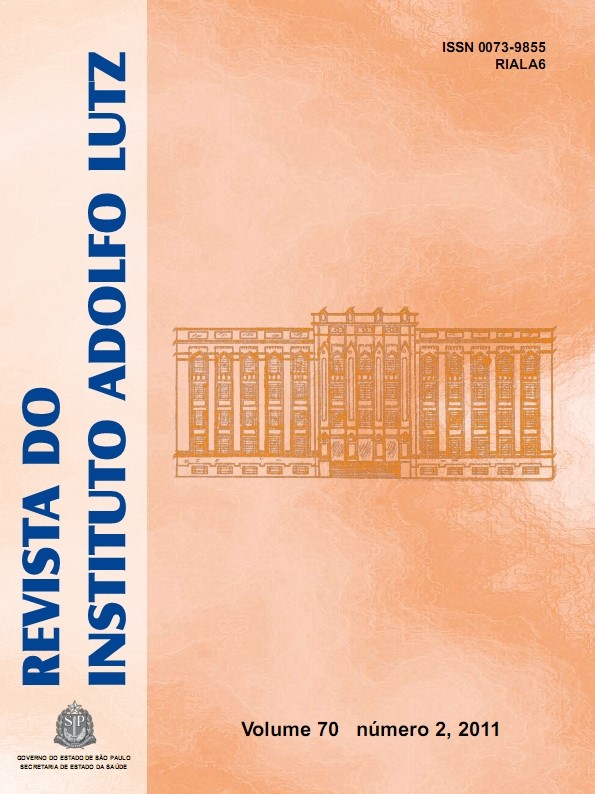Resumen
A criopreservação de vírus da raiva tem sido descrita de forma sucinta na literatura científica. Até o presente, poucas informações encontram-se disponíveis sobre o uso de agentes crioprotetores na conservação a frio de vírus da raiva. O objetivo deste trabalho foi de analisar a viabilidade de vírus da raiva expostos aos procedimentos de congelação/descongelação e de avaliar o efeito do dimetilsulfóxido (DMSO), do glicerol (GLI), do polietilenoglicol (PEG) e da sacarose (SAC), em diferentes concentrações, na criopreservação de vírus da raiva. A viabilidade viral foi testada por meio de isolamento viral utilizando-se testes de inoculação em camundongos, titulação viral e imunofluorescência direta antes e 30 dias após terem sido instituídos os protocolos de congelação. A viabilidade das amostras de vírus da raiva após criopreservação na ausência de agentes crioprotetores foi inferior àquela observada em outros tratamentos. Após 30 dias de congelação, a viabilidade das amostras criopreservadas com adição de DMSO, GLI e PEG foi mais baixa do que a observada em amostras frescas. Adicionalmente, o uso da sacarose nas concentrações de 10% ou 68% induziu efeitos positivos na viabilidade das partículas virais após criopreservação a curto prazo.
Citas
1. Day JG, McLellan MR. Cryopreservation and freeze-drying protocols. New Jersey: Humana Press; 1995.
2. Paoli DP. Biobanking in microbiology: from sample collection to epidemiology, diagnosis and research. FEMS Microbiol Rev. 2005;29:897-910.
3. Hubálek Z. Protectants used in the cryopreservation of microorganisms. Cryobiol. 2003;46:205-29.
4. Gould EA. Virus cryopreservation and storage. In: Day JG, McLellan MR. Cryopreservation and freeze-drying protocols. New Jersey: Humana Press; 1995.
5. Paynter SJ. Principles and practical issues for cryopreservation of nerve cells. Brain Res Bull. 2008;75:1-14.
6. Howell CL, Miller MJ. Effect of sucrose phosphate and sorbitol on infectivity of enveloped viruses during storage. J Clin Microbiol. 1983;3:658-62.
7. Koprowski H. The mouse inoculation test. In: Meslin FX, Kaplan MM, Koprowski H. (Eds). Laboratory Techniques in Rabies, 4th ed. Geneva: World Health Organization; 1996. p.80-86.
8. Reed LJ, Müench H. A simple method of estimating fifty per cent endpoints. Am J Hyg. 1938;27:493-7.
9. Dean DJ, Abelset MK, Atanasiu P. The fluorescent antibody test. In: Meslin FX, Kaplan MM, Koprowski H. (Eds). Laboratory Techniques in Rabies, 4th ed. Geneva: World Health Organization; 1996. p.88-95.
10. Bingham J, Merwe M. Distribution of rabies antigen in infected brain material: determining the reliability of different regions of the brain for the rabies fluorescent antibody text. J Virol Methods. 2002;101:85-94.
11. Schnell MJ, McGettigan JP, Wirblich C, Papaneri A. The cell biology of rabies virus: using stealth to reach the brain. Nat Rev Microbiol. 2010;8:51-61.
12. Wacharapluesadee S, Ruangvejvorachai P, Hemachuda T. A simple method for detection of rabies viral sequences in 16-year old archival brain specimens with one-week fixation in formalin. J Virol Methods. 2006;134:267-71.
13. Lopes MC, Venditti LLR, Queiroz LH. Comparison between RT-PCR and the mouse inoculation test for detection of rabies virus in samples kept for long periods under different conditions. J Virol Methods. 2010;164:19-23.
14. Fabbri R, Porcu E, Marsella T, Rocchetta G, Venturoli S, Flamigni C. Human oocyte cryopreservation: new perspectives regarding oocyte survival. Hum Reprod. 2001;16:411-6.
15. Chen ZJ, Li M, Li Y, Zhao LX, Tang R, Sheng Y, Gao X, Chang CH, Feng HL. Effects of sucrose concentration on the developmental potential of human frozen-thawed oocytes at different stages of maturity. Hum Reprod. 2004;10:2345-9.

Esta obra está bajo una licencia internacional Creative Commons Atribución 4.0.
Derechos de autor 2011 Revista del Instituto Adolfo Lutz
